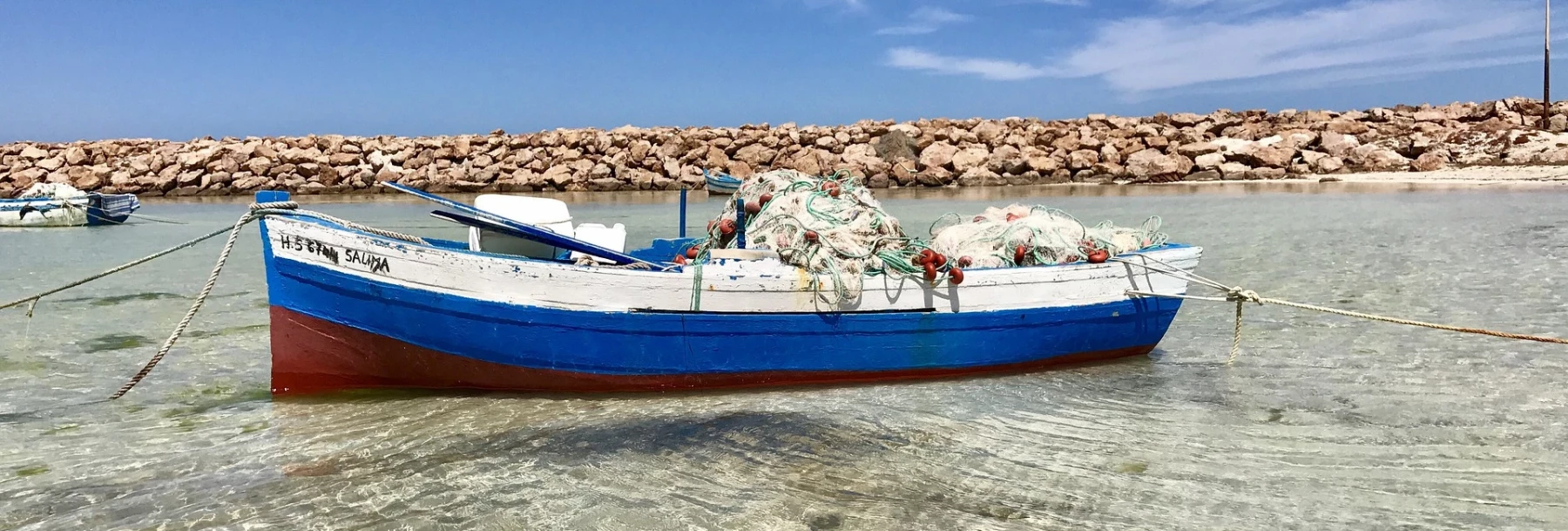Les 7 choses incontournables à faire à Djerba
Dernière mise à jour : 26/05/2024 15:37Sommaire
- A visiter
-
- 1 - Houmt-Souk
- 2 - Borj El Kebir
- 3 - La synagogue de la Ghriba
- 4 - Midoun
- 5 - Musée de Guellala
- 6 - Les plages de Djerba
- 7 - Djerbahood
- Djerba - Où Loger ?
- Djerba - Comment se déplacer ?
- Djerba - Meilleure période
Explorez l'île enchanteresse de Djerba, un joyau méditerranéen qui séduit par son histoire riche, sa culture vibrante et ses paysages époustouflants. Avec ses plages immaculées, ses eaux azurées et ses sites historiques, Djerba est une destination captivante pour les voyageurs en quête de détente et de découverte.
Flânez dans les ruelles étroites de Houmt Souk, la principale ville, où marchés colorés et souks traditionnels offrent un aperçu de la vie locale. Découvrez le charme historique de Borj El Kebir, une forteresse offrant des vues panoramiques racontant l'histoire de l'île. Explorez l'architecture distinctive de Guellala, réputée pour ses habitations troglodytiques.
Immergez-vous dans la richesse culturelle de l'île à la synagogue El Ghriba, symbole de diversité religieuse et de signification historique. Ressentez la douce brise en vous promenant le long des plages de sable blanc, comme celles de Sidi Mahres, offrant une évasion sereine.
Djerba, avec ses oasis bordées de palmiers et ses paysages luxuriants, offre une retraite tranquille. L'authenticité de l'île se révèle également dans ses villages traditionnels, où le temps semble suspendu, et lors de ses festivals, où la musique animée et les couleurs vives prennent vie.
Savourez la cuisine locale, riche en saveurs influencées par les traditions berbères, arabes et méditerranéennes. Délectez-vous de fruits de mer frais, d'épices aromatiques et de délices sucrés reflétant le patrimoine culinaire de l'île.
Djerba, avec son hospitalité chaleureuse et ses attractions diversifiées, promet un voyage inoubliable où le confort moderne s'harmonise avec le charme ancien. Que vous vous prélassiez sur des plages ensoleillées ou exploriez les trésors culturels de l'île, Djerba invite les voyageurs à vivre une expérience parfaite mêlant détente et immersion culturelle.
1 - Houmt-Souk
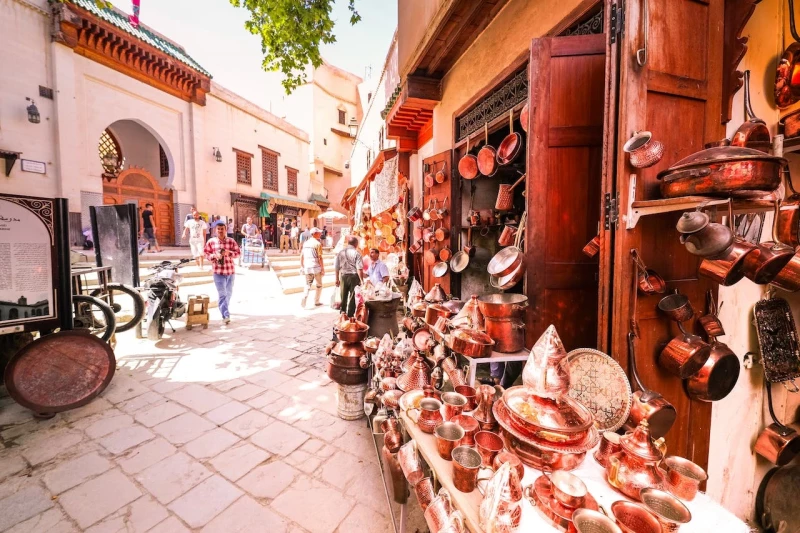
Plongez au cœur de Houmt Souk, la ville principale de l'île de Djerba en Tunisie, où l'histoire ancienne se mêle à la vie quotidienne dynamique. Dans cette médina envoûtante, les ruelles étroites dévoilent un kaléidoscope de couleurs, d'odeurs et de sons, offrant aux visiteurs une immersion authentique dans la culture tunisienne.
Le marché de Houmt Souk est un véritable trésor, où les échoppes débordent de produits locaux, d'épices parfumées et d'artisanat traditionnel. Les marchands animent les lieux avec leur hospitalité chaleureuse, vous invitant à découvrir des trésors cachés et à déguster des saveurs exotiques.
La Grande Mosquée, au cœur de la médina, émerge avec une majesté architecturale, rappelant l'héritage islamique de la région. Les ruelles pavées vous guident à travers des édifices historiques, des cours ombragées et des places animées, où la vie locale prend toute son intensité.
Les cafés traditionnels, avec leurs théières fumantes et leurs narguilés parfumés, offrent un havre de paix pour observer le rythme tranquille de la vie à Houmt Souk. L'atmosphère détendue contraste avec la vivacité des souks, créant une harmonie unique entre tradition et modernité.
À Houmt Souk, chaque coin de rue semble raconter une histoire ancienne, tandis que les vendeurs et les habitants vous accueillent avec un sourire sincère. La ville, avec son charme authentique et son ambiance animée, invite les voyageurs à se perdre dans ses dédales pittoresques et à découvrir l'essence même de la culture tunisienne.
 Nos astuces pour tirer le meilleur parti de votre expérience.
Nos astuces pour tirer le meilleur parti de votre expérience.
Visiter Houmt Souk à Djerba peut être une expérience enrichissante, offrant une plongée dans la culture tunisienne authentique. Voici quelques astuces pour tirer le meilleur parti de votre visite à Houmt Souk :
-
Explorez la Médina : Perdez-vous dans les ruelles sinueuses de la médina pour découvrir des marchés colorés, des échoppes artisanales, et des coins cachés. Les ruelles regorgent de trésors locaux, et l'exploration à pied permet une immersion totale dans l'atmosphère locale.
-
Marchandez avec Sagesse : La négociation est une partie intégrante de l'expérience d'achat dans les souks. Soyez amical, mais n'hésitez pas à marchander le prix. C'est souvent une tradition locale, et cela peut rendre l'expérience d'achat plus interactive.
-
Découvrez le Marché Central : Le marché central de Houmt Souk est un incontournable. Vous y trouverez des produits frais, des épices exotiques, des tissus colorés et bien d'autres articles. C'est un excellent endroit pour découvrir la vie quotidienne locale.
-
Visitez la Grande Mosquée : Admirez l'architecture de la Grande Mosquée au cœur de la médina. Bien que l'accès à l'intérieur puisse être limité pour les non-musulmans, l'extérieur offre des vues impressionnantes.
-
Dégustez la Cuisine Locale : Ne manquez pas l'occasion de goûter à la cuisine locale. Les cafés et les petits restaurants proposent des plats traditionnels, comme le couscous, les tajines et les pâtisseries locales. Essayez également un café ou un thé à la menthe dans l'un des cafés traditionnels.
-
Soyez Respectueux des Coutumes Locales : Gardez à l'esprit les coutumes locales et vestimentaires, surtout si vous visitez des lieux religieux. Habillez-vous modestement et demandez la permission avant de prendre des photos, en particulier des habitants.
-
Explorez en Matinée : Pour éviter les foules, envisagez de visiter Houmt Souk tôt le matin. C'est souvent le moment idéal pour une expérience plus paisible et pour capturer la vie locale au lever du soleil.
-
Prenez le Temps de Parler avec les Locaux : Les habitants de Houmt Souk sont connus pour leur hospitalité. N'hésitez pas à engager la conversation avec les locaux, que ce soit dans les marchés, les cafés ou les rues. Cela peut vous offrir des perspectives uniques et des conseils précieux.
En suivant ces astuces, vous pouvez créer une expérience mémorable lors de votre visite à Houmt Souk, plongeant au cœur de la vie quotidienne et de la richesse culturelle de cette charmante ville tunisienne.
2 - Borj El Kebir
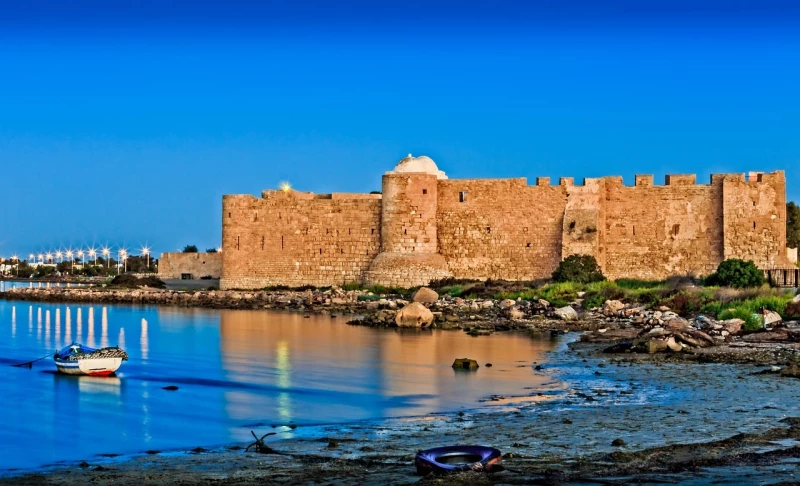
Perché sur les hauteurs de Djerba, Borj El Kebir se dresse en majesté, offrant une expérience captivante pour les amateurs de voyages en quête d'histoire et de panoramas panoramiques. Cette forteresse historique, également connue sous le nom de Borj Ghazi Mustapha, raconte des récits anciens et offre une vue imprenable sur l'île et au-delà.
La silhouette imposante de Borj El Kebir s'érige contre le ciel, témoignage d'un passé riche en événements et en influences. Construit au XVème siècle par les Espagnols puis reconstruit par les Ottomans, le site a connu des siècles de transformations, abritant des garnisons militaires et des gouverneurs successifs.
Les visiteurs qui franchissent les portes de la forteresse sont transportés dans le temps. Les murs de pierre épais, les passages voûtés et les cours intérieures évoquent l'époque des conflits historiques et des stratégies militaires. Des canons anciens rappellent l'époque où Borj El Kebir jouait un rôle défensif stratégique.
L'ascension des escaliers en colimaçon jusqu'aux remparts offre une vue panoramique spectaculaire sur l'île, la mer Méditerranée et les paysages environnants. Les visiteurs peuvent contempler le contraste entre les toits blanchis à la chaux des bâtiments de Djerba, les palmiers ondulants et les eaux scintillantes.
Borj El Kebir est plus qu'un simple vestige historique ; c'est une fenêtre ouverte sur le passé, offrant aux voyageurs la possibilité de comprendre l'importance stratégique de Djerba au fil des siècles. Que ce soit pour son architecture imposante, ses vues à couper le souffle ou son aura chargée d'histoire, une visite à Borj El Kebir promet une immersion inoubliable dans le patrimoine de l'île.
 Nos astuces pour tirer le meilleur parti de votre expérience.
Nos astuces pour tirer le meilleur parti de votre expérience.
Explorer Borj El Kebir à Djerba est une expérience fascinante, riche en histoire et en vues panoramiques. Voici quelques astuces pour tirer le meilleur parti de votre visite à cette forteresse historique :
-
Horaires d'ouverture : Assurez-vous de connaître les horaires d'ouverture de Borj El Kebir avant de planifier votre visite. Cela vous permettra d'optimiser votre temps sur place.
-
Guides locaux : Engager un guide local peut enrichir votre expérience en fournissant des informations détaillées sur l'histoire de Borj El Kebir et de la région environnante. Les guides peuvent également partager des anecdotes fascinantes.
-
Chaussures confortables : Étant donné que vous pourriez avoir à monter des escaliers ou à vous déplacer sur des surfaces irrégulières, des chaussures confortables sont recommandées pour assurer une visite agréable.
-
Protection solaire : En raison de l'exposition au soleil, surtout si vous visitez pendant les heures chaudes de la journée, n'oubliez pas d'appliquer de la crème solaire, de porter un chapeau et des lunettes de soleil.
-
Photographie : Apportez un appareil photo pour capturer les vues spectaculaires depuis les remparts de la forteresse. Assurez-vous de respecter les règles de photographie en vigueur sur le site.
-
Explorez chaque recoin : Prenez le temps d'explorer chaque partie de la forteresse, des cours intérieures aux remparts. Chaque recoin offre une perspective unique sur l'histoire et les paysages environnants.
-
Temps de visite : Pour éviter les foules, envisagez de planifier votre visite tôt le matin ou en fin d'après-midi. Cela vous permettra de profiter pleinement de l'expérience sans être pressé par la foule.
-
Respectez les règles locales : Soyez conscient des règles et des coutumes locales. Respectez les panneaux d'information et les indications du personnel sur place pour garantir une visite respectueuse et agréable.
-
Événements spéciaux : Renseignez-vous sur d'éventuels événements spéciaux ou festivals qui pourraient avoir lieu à Borj El Kebir. Participer à des événements locaux peut ajouter une dimension culturelle à votre visite.
En suivant ces astuces, votre visite à Borj El Kebir sera non seulement informative sur le plan historique, mais aussi agréable et mémorable. Profitez de chaque moment pour découvrir l'histoire et la beauté de cet emblème historique de Djerba.
3 - La synagogue de la Ghriba
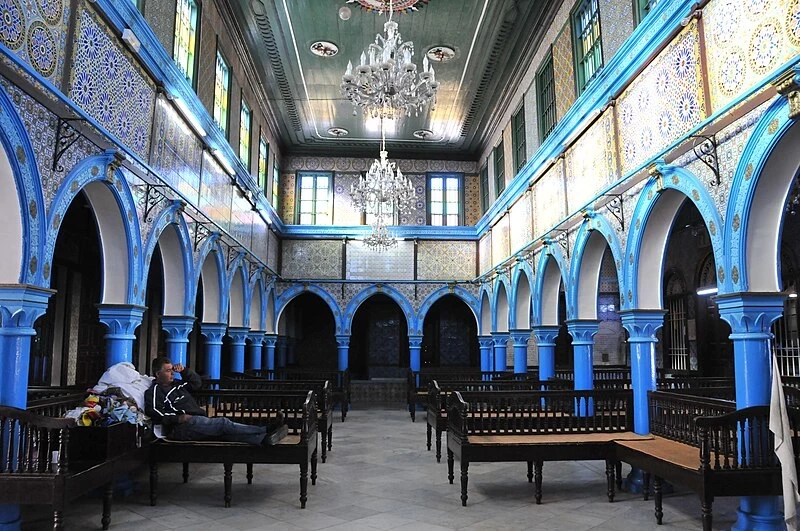
La synagogue de la Ghriba, située sur l'île de Djerba en Tunisie, est une destination de voyage empreinte d'histoire, de spiritualité et de charme culturel. Voici une description pour le thème voyage :
La synagogue de la Ghriba se dresse fièrement, témoin vivant de siècles d'histoire et de coexistence religieuse. Nichée au cœur de l'ancien quartier juif d'Hara Sghira, cette synagogue, considérée comme l'une des plus anciennes du monde, évoque un riche héritage séfarade.
À première vue, la façade blanche immaculée et les éléments architecturaux distinctifs de la Ghriba dévoilent une élégance sobre. Cependant, à mesure que l'on pénètre à l'intérieur, l'atmosphère se charge de spiritualité. Les murs résonnent des murmures de prières anciennes, tandis que les vitraux colorés filtrent la lumière du soleil, créant une ambiance sacrée et apaisante.
La Ghriba est réputée pour abriter une Torah antique, précieusement conservée et vénérée par la communauté juive locale. Chaque année, la fête de Lag Ba'Omer attire des pèlerins de divers horizons, témoignant de la vitalité de cette tradition millénaire.
Les ruelles étroites menant à la synagogue sont parsemées de boutiques artisanales proposant des souvenirs uniques, des étoffes colorées et des objets d'artisanat traditionnels. Les visiteurs peuvent se perdre dans ce labyrinthe culturel, découvrant l'âme authentique de la communauté.
La synagogue de la Ghriba, avec sa combinaison unique d'histoire, d'architecture et de spiritualité, offre aux voyageurs une immersion profonde dans la richesse culturelle de Djerba. Que ce soit pour des raisons religieuses, historiques ou simplement pour l'exploration, une visite à la Ghriba promet une expérience de voyage inoubliable.
 Nos astuces pour tirer le meilleur parti de votre expérience.
Nos astuces pour tirer le meilleur parti de votre expérience.
Visiter la Synagogue de la Ghriba à Djerba est une expérience culturelle et spirituelle unique. Voici quelques astuces pour tirer le meilleur parti de votre visite :
-
Horaires d'ouverture : Assurez-vous de connaître les horaires d'ouverture de la synagogue avant de planifier votre visite. Les horaires peuvent varier en fonction des jours de la semaine et des événements spéciaux.
-
Respect des coutumes : En tant que lieu de culte, respectez les coutumes locales et religieuses. Portez des vêtements modestes et suivez les indications du personnel sur place concernant les règles et les pratiques à respecter.
-
Guides locaux : Engager un guide local peut enrichir votre visite en vous fournissant des informations approfondies sur l'histoire de la synagogue et de la communauté juive de Djerba. Les guides peuvent également partager des récits fascinants.
-
Fête de Lag Ba'Omer : Si votre visite coïncide avec la fête de Lag Ba'Omer, soyez prêt à vivre une expérience particulière. La synagogue attire de nombreux pèlerins à cette période, créant une atmosphère vibrante et festive.
-
Exploration du quartier : Profitez de votre visite pour explorer le quartier environnant. Les ruelles étroites regorgent de boutiques artisanales, offrant des souvenirs uniques et des produits locaux.
-
Photographie : Respectez les règles en vigueur concernant la photographie à l'intérieur de la synagogue. Certaines zones peuvent être restreintes, alors assurez-vous de demander la permission avant de prendre des photos.
-
Participation aux rituels : Si vous vous sentez à l'aise, observez silencieusement les rituels qui peuvent avoir lieu à la synagogue. Cela peut offrir une perspective plus profonde sur la vie communautaire.
-
Apprentissage préalable : Avant votre visite, prenez le temps d'en apprendre davantage sur l'histoire de la Ghriba. Cela vous permettra d'apprécier davantage les détails et les symboles présents dans la synagogue.
-
Respect de la tranquillité : Étant un lieu de culte, gardez un ton de voix bas et respectez la tranquillité des lieux. Cela contribuera à maintenir une atmosphère respectueuse pour les visiteurs et les fidèles.
En suivant ces astuces, votre visite à la Synagogue de la Ghriba sera une expérience enrichissante, vous permettant de vous immerger pleinement dans l'histoire et la spiritualité de ce lieu emblématique.
4 - Midoun
Plongez au cœur de Midoun, une ville enchanteresse située sur l'île de Djerba en Tunisie, où l'histoire, la culture et la beauté naturelle fusionnent pour créer une destination de voyage captivante.
Midoun se déploie avec l'élégance de ses rues bordées de palmiers, offrant une atmosphère paisible qui contraste avec l'effervescence des souks animés. La médina de Midoun est un tableau vivant de l'artisanat local, où des échoppes colorées débordent de tissus chatoyants, de poteries artisanales et de souvenirs uniques.
Les marchés en plein air révèlent une explosion de couleurs et de saveurs, avec des étals débordant de produits locaux, d'épices parfumées et de fruits frais. C'est une invitation irrésistible à goûter aux délices de la cuisine locale et à se perdre dans les ruelles animées.
Les plages immaculées de Midoun, bordées par les eaux turquoises de la Méditerranée, offrent une escapade idyllique pour les amoureux du soleil. Les complexes hôteliers en front de mer proposent des expériences de détente ultime, complétées par des vues panoramiques sur la mer.
Le patrimoine historique de Midoun transparaît dans des sites tels que le Musée de Guellala, où les visiteurs peuvent plonger dans l'histoire de l'île et de ses habitants. Les architectures traditionnelles, les dômes blancs des mosquées et les petites ruelles pavées ajoutent une touche de charme antique à cette ville moderne.
L'hospitalité chaleureuse des habitants de Midoun crée une atmosphère accueillante, invitant les voyageurs à se perdre dans ses ruelles, à explorer ses marchés animés et à se détendre sur ses plages dorées. Midoun, avec son mélange harmonieux de tradition et de modernité, promet une expérience de voyage inoubliable sur l'île ensoleillée de Djerba.
 Nos astuces pour tirer le meilleur parti de votre expérience.
Nos astuces pour tirer le meilleur parti de votre expérience.
Explorer Midoun à Djerba offre une expérience authentique entre histoire, culture et détente. Voici quelques astuces pour tirer le meilleur parti de votre visite :
-
Découvrir la Médina : Perdez-vous dans la médina de Midoun, explorez ses ruelles pittoresques, et découvrez les échoppes locales proposant des produits artisanaux. C'est une excellente façon de s'immerger dans la vie quotidienne et la culture locale.
-
Marchander au Souk : Les souks de Midoun offrent une variété de produits locaux. N'hésitez pas à marchander les prix, mais faites-le de manière respectueuse et amicale. C'est souvent une partie intégrante de l'expérience d'achat.
-
Déguster la Cuisine Locale : Explorez les restaurants locaux pour savourer la délicieuse cuisine tunisienne. Ne manquez pas les plats traditionnels comme le couscous, les tajines, et les pâtisseries locales. Les cafés offrent également une occasion idéale pour goûter au thé à la menthe tunisien.
-
Explorer les Plages : Profitez des plages de Midoun pour vous détendre. Certains hôtels proposent des activités nautiques, tandis que d'autres offrent simplement un lieu paisible pour bronzer.
-
Visiter le Musée de Guellala : Explorez le Musée de Guellala pour en apprendre davantage sur l'histoire et la culture de Djerba. Les expositions présentent des artefacts locaux et des éléments de la vie quotidienne sur l'île.
-
Engager une Conversation : Les habitants de Midoun sont généralement chaleureux et accueillants. N'hésitez pas à engager une conversation avec les locaux pour obtenir des recommandations ou en savoir plus sur la vie sur l'île.
-
Respecter les Coutumes Locales : Soyez conscient des coutumes locales et des normes vestimentaires, surtout si vous visitez des sites religieux. Habillez-vous modestement et respectez les règles en vigueur.
-
Se Promener dans les Vergers : Djerba est réputée pour ses vergers, notamment d'oliviers et de palmiers. Profitez d'une promenade tranquille dans ces vergers pour apprécier la beauté naturelle de l'île.
-
Assister à des Événements Locaux : Renseignez-vous sur d'éventuels événements ou festivals locaux qui pourraient avoir lieu pendant votre séjour. Participer à des célébrations locales peut ajouter une dimension culturelle à votre expérience.
En suivant ces astuces, votre visite à Midoun sera une aventure enrichissante, mêlant découverte culturelle et moments de détente sur cette île ensoleillée de la Méditerranée.
5 - Musée de Guellala
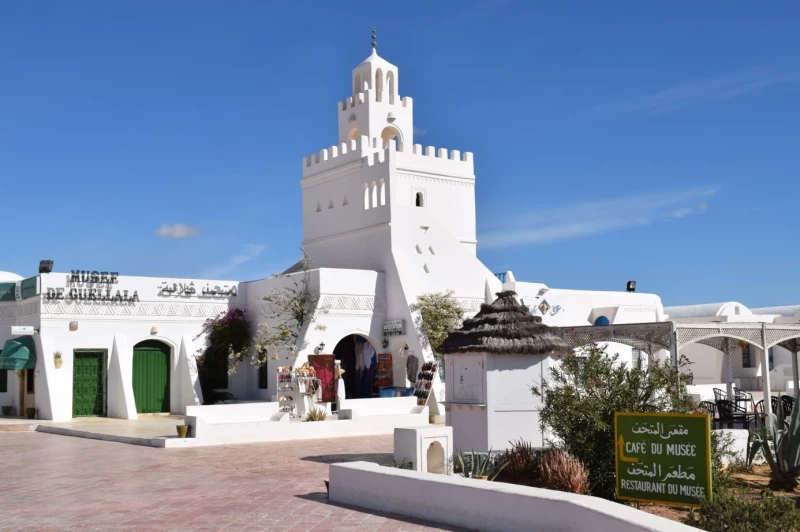
Le Musée de Guellala, situé sur l'île de Djerba en Tunisie, est une destination incontournable pour les amateurs de voyage en quête d'une plongée captivante dans l'histoire et la culture de la région. Voici une description pour le thème voyage :
Le Musée de Guellala se dresse comme un gardien du patrimoine, offrant aux visiteurs une fenêtre ouverte sur les traditions, les coutumes et les évolutions de la vie sur l'île de Djerba. Implanté dans le village de Guellala, ce musée enchanteur présente une collection éclectique d'artefacts, d'objets artisanaux et d'éléments témoignant de l'histoire riche et diversifiée de la région.
À l'intérieur du musée, les visiteurs sont transportés à travers le temps, explorant les différentes périodes qui ont façonné Djerba. Des expositions mettent en lumière l'art traditionnel, les métiers locaux, et les aspects de la vie quotidienne des habitants de l'île. Les textiles colorés, les poteries exquises et les outils anciens racontent l'histoire d'une communauté créative et ingénieuse.
Un point fort du Musée de Guellala réside dans sa capacité à préserver et à présenter les coutumes uniques de Djerba. Des reconstitutions de scènes de la vie quotidienne, des rituels traditionnels, et des festivités locales sont présentés de manière immersive, permettant aux visiteurs de plonger au cœur de la culture locale.
Les jardins entourant le musée ajoutent une touche pittoresque à l'expérience, offrant aux visiteurs un espace paisible pour se promener et réfléchir sur ce qu'ils ont découvert à l'intérieur. Les expositions en plein air comprennent parfois des sculptures ou des installations artistiques, créant une ambiance artistique qui se marie harmonieusement avec l'environnement.
En visitant le Musée de Guellala, les voyageurs ont l'opportunité d'apprécier l'héritage riche et diversifié de Djerba, tout en nourrissant leur curiosité pour les traditions locales et l'artisanat authentique de cette île ensoleillée de la Méditerranée.
 Nos astuces pour tirer le meilleur parti de votre expérience.
Nos astuces pour tirer le meilleur parti de votre expérience.
Le musée de Guellala se trouve sur l'île de Djerba en Tunisie et est réputé pour abriter une collection d'objets traditionnels et d'artisanat local. Voici quelques astuces pour rendre votre visite plus agréable :
-
Horaires d'ouverture : Vérifiez les horaires d'ouverture du musée avant de planifier votre visite. Les horaires peuvent varier en fonction des jours de la semaine et des saisons.
-
Billets : Assurez-vous d'acheter vos billets à l'avance si possible, cela vous permettra de gagner du temps à l'entrée du musée.
-
Guide touristique : Si vous souhaitez en apprendre davantage sur l'histoire et la signification des objets exposés, envisagez de prendre un guide touristique. Cela peut enrichir votre expérience en fournissant des informations contextuelles.
-
Tenue vestimentaire : Comme pour de nombreux lieux culturels, il est conseillé de s'habiller modestement par respect pour la culture locale.
-
Photographie : Renseignez-vous sur la politique du musée en matière de photographie. Certains endroits peuvent avoir des restrictions, par exemple dans les salles d'exposition.
-
Temps de visite : Prévoyez suffisamment de temps pour explorer le musée sans être pressé. Cela vous permettra de profiter pleinement de chaque exposition.
-
Respect des règles : Respectez les règles du musée, y compris celles concernant le toucher des objets exposés. Certaines pièces peuvent être fragiles ou sensibles à la lumière.
-
Langue : Si vous ne parlez pas la langue locale, assurez-vous que le musée propose des informations dans une langue que vous comprenez. Certains musées fournissent des audioguides dans plusieurs langues.
-
Interactivité : Certains musées ont des expositions interactives. N'hésitez pas à participer et à profiter de ces expériences pour une immersion plus complète.
-
Se renseigner à l'avance : Avant de visiter le musée, faites quelques recherches sur son histoire, ses collections et ses expositions temporaires éventuelles. Cela rendra votre visite plus intéressante et significative.
En suivant ces astuces, vous devriez avoir une expérience agréable et enrichissante lors de votre visite au musée de Guellala.
6 - Les plages de Djerba
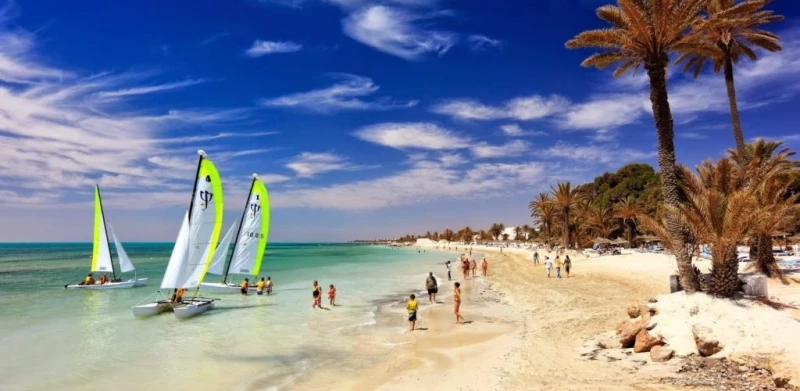
Djerba, une île située au sud-est de la Tunisie, est réputée pour ses plages magnifiques. Voici quelques-unes des plages les plus populaires de Djerba :
-
Plage de Sidi Mahrez : C'est l'une des plages les plus célèbres de Djerba. Elle est connue pour ses eaux claires, son sable fin et ses palmiers. La plage de Sidi Mahrez est également appréciée pour ses conditions de baignade agréables.
-
Plage de Seguia : Cette plage est située du côté est de l'île et est appréciée pour sa tranquillité. Si vous recherchez une plage plus isolée et paisible, la plage de Seguia peut être un excellent choix.
-
Plage d'Aghir : Située au sud-est de l'île, la plage d'Aghir offre un cadre naturel préservé. Elle est moins fréquentée que certaines plages plus populaires, ce qui en fait un endroit idéal pour ceux qui recherchent la tranquillité.
-
Plage de Ras R'mal : Connue pour ses dunes de sable impressionnantes, la plage de Ras R'mal est un endroit magnifique pour se détendre et profiter du soleil. Les couchers de soleil depuis cette plage sont particulièrement spectaculaires.
-
Plage de Sidi Djmour : Cette plage est appréciée pour son sable doré et ses eaux cristallines. Elle offre également une vue panoramique sur la Méditerranée.
-
Plage de Meninx : Située du côté nord de l'île, la plage de Meninx est connue pour ses eaux peu profondes, ce qui la rend idéale pour la baignade, surtout si vous voyagez en famille.
-
Plage de la Playa : Proche de la zone touristique, la plage de la Playa est entourée d'hôtels, de restaurants et d'installations touristiques. C'est un endroit populaire pour ceux qui aiment avoir des commodités à proximité.
Lorsque vous visitez les plages de Djerba, assurez-vous de respecter l'environnement en évitant de laisser des déchets et en suivant les règles locales. Profitez de votre temps au soleil et de la beauté naturelle de l'île.
 Nos astuces pour tirer le meilleur parti de votre expérience.
Nos astuces pour tirer le meilleur parti de votre expérience.
Explorer les plages de Djerba peut être une expérience mémorable. Voici quelques astuces pour rendre votre visite encore plus agréable :
-
Protection solaire : Les rayons du soleil peuvent être forts, surtout en été. Assurez-vous d'apporter une crème solaire à indice élevé, un chapeau et des lunettes de soleil pour vous protéger contre les coups de soleil.
-
Hydratation : En raison du climat méditerranéen, il est essentiel de rester hydraté. Apportez suffisamment d'eau pour éviter la déshydratation, surtout si vous prévoyez de passer beaucoup de temps au soleil.
-
Équipement de plage : N'oubliez pas d'apporter des éléments essentiels tels que des serviettes de plage, un parasol, et éventuellement des chaises pliantes pour plus de confort.
-
Chaussures adaptées : Certaines plages peuvent avoir des zones rocheuses ou des coquillages. Des chaussures d'eau confortables peuvent être utiles pour éviter tout inconfort pendant la baignade.
-
Collations légères : Emballez quelques collations légères pour recharger vos batteries tout en profitant du soleil. Évitez de laisser des déchets sur la plage en utilisant des sacs poubelles.
-
Activités nautiques : Si vous êtes intéressé par des activités nautiques telles que la plongée en apnée, le kayak ou la planche à voile, vérifiez si ces services sont disponibles sur la plage que vous visitez.
-
Respect de l'environnement : Soyez respectueux de l'environnement en évitant de perturber la faune et la flore locales. Ne laissez aucun déchet sur la plage et suivez les règles éventuelles du site.
-
Exploration des environs : Profitez de votre visite pour explorer les environs. Djerba a une riche histoire et culture, et il pourrait y avoir des sites intéressants à découvrir à proximité des plages.
-
Horaires : Si possible, choisissez des horaires de plage tôt le matin ou en fin d'après-midi pour éviter les heures les plus chaudes de la journée.
-
Sécurité : Respectez les consignes de sécurité affichées sur la plage et surveillez les conditions de baignade. Si des sauveteurs sont présents, suivez leurs conseils.
En suivant ces astuces, vous devriez profiter au maximum de votre visite sur les plages de Djerba.
7 - Djerbahood
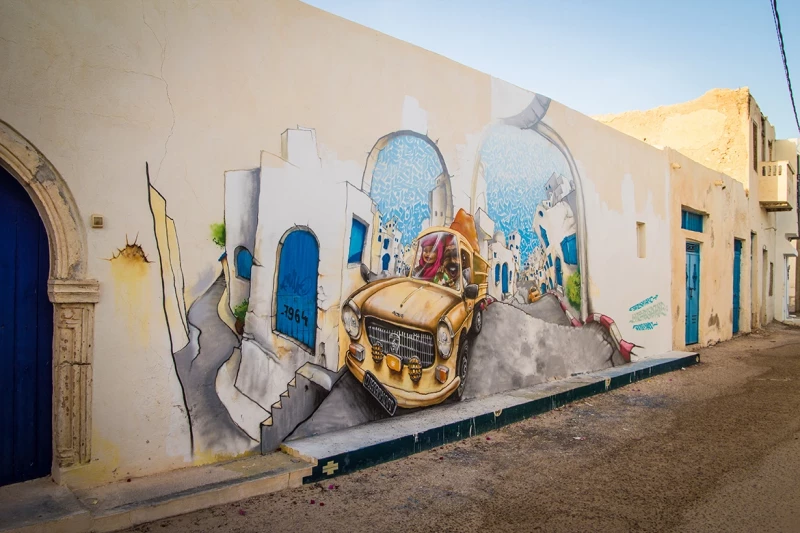
"Djerbahood" fait référence à un projet artistique international qui a transformé l'île de Djerba, en Tunisie, en un musée en plein air à ciel ouvert. Ce projet a été lancé en 2014 et a attiré des artistes du monde entier pour créer des œuvres d'art murales dans le village d'Erriadh sur l'île.
Voici quelques points clés concernant Djerbahood :
-
Contexte artistique : L'idée derrière Djerbahood était de transformer un village traditionnel en un espace artistique contemporain. Les artistes ont utilisé les murs des maisons, les portes et les ruelles comme toiles pour exprimer leur créativité.
-
Artistes internationaux : Plus de 150 artistes internationaux ont participé au projet, apportant une diversité de styles artistiques, de techniques et de cultures. Les œuvres d'art résultantes sont un mélange éclectique de couleurs, de formes et de messages.
-
Interaction avec la communauté : Le projet visait à impliquer la communauté locale dans le processus artistique et à créer un dialogue entre les artistes et les habitants. Cela a permis de créer une connexion entre l'art contemporain et les traditions locales.
-
Tourisme culturel : Djerbahood a également attiré l'attention des touristes et des amateurs d'art du monde entier. Le projet a contribué à promouvoir le tourisme culturel sur l'île, offrant aux visiteurs une expérience unique en explorant les ruelles transformées en galeries d'art.
-
Événements associés : En plus de la création des œuvres d'art, Djerbahood a été accompagné d'événements culturels, d'expositions et de festivals pour célébrer la créativité et l'expression artistique.
-
Impact sur la communauté : Le projet a laissé un impact significatif sur la communauté locale en revitalisant visuellement le village et en créant une attraction culturelle durable.
Djerbahood représente une convergence unique entre l'art contemporain, la tradition locale et le tourisme culturel, faisant de Djerba un lieu emblématique dans le domaine de l'art urbain en plein air.
 Nos astuces pour tirer le meilleur parti de votre expérience.
Nos astuces pour tirer le meilleur parti de votre expérience.
Visiter Djerbahood peut être une expérience artistique unique. Voici quelques astuces pour tirer le meilleur parti de votre visite :
-
Renseignez-vous à l'avance : Avant votre visite, renseignez-vous sur les artistes qui ont contribué à Djerbahood et sur les œuvres spécifiques que vous aimeriez voir. Cela peut vous donner un aperçu plus approfondi de l'art et de son contexte.
-
Carte ou visite guidée : Obtenez une carte de Djerbahood ou envisagez de participer à une visite guidée. Cela peut vous aider à repérer les principales œuvres d'art et à comprendre les histoires et les messages derrière chaque création.
-
Respectez l'environnement : Lors de votre visite, assurez-vous de respecter l'environnement artistique. Évitez de toucher les œuvres d'art, respectez les règles locales et veillez à ne pas perturber le travail des artistes.
-
Temps de visite : Prévoyez suffisamment de temps pour explorer Djerbahood sans vous sentir pressé. Cela vous permettra de savourer pleinement les détails des œuvres d'art et de capturer des photos si vous le souhaitez.
-
Horaire de la journée : La lumière du matin ou de l'après-midi peut mettre en valeur les couleurs des œuvres d'art. Essayez de planifier votre visite à ces moments de la journée pour une expérience visuelle optimale.
-
Comprendre le contexte culturel : Profitez de votre visite pour en apprendre davantage sur la culture locale. Les œuvres d'art de Djerbahood sont souvent liées à l'histoire et aux traditions de l'île, ce qui peut ajouter une dimension supplémentaire à votre expérience.
-
Rencontre avec les habitants : Si possible, engagez la conversation avec les habitants du village. Ils pourraient partager des perspectives intéressantes sur Djerbahood et vous donner des informations locales supplémentaires.
-
Événements spéciaux : Consultez s'il y a des événements spéciaux, des festivals artistiques ou des expositions temporaires prévus pendant votre visite. Cela pourrait enrichir votre expérience avec des activités culturelles supplémentaires.
-
Transport : Assurez-vous d'avoir un moyen de transport fiable pour vous rendre à Djerbahood, que ce soit en taxi, en voiture de location ou autre. Certains endroits peuvent être éloignés, et un moyen de transport facilitera vos déplacements.
-
Partagez votre expérience : Partagez vos photos et expériences sur les réseaux sociaux si vous le souhaitez. Cela peut contribuer à promouvoir l'art et attirer l'attention sur Djerbahood.
En suivant ces astuces, vous devriez pouvoir apprécier pleinement l'expérience artistique qu'offre Djerbahood.
Djerba - Où Loger ?
À Djerba, vous avez plusieurs options d'hébergement adaptées à différents budgets et préférences. Voici quelques suggestions pour vous aider à choisir où loger à Djerba :
-
Houmt Souk : La principale ville de l'île, Houmt Souk, offre une variété d'hébergements, des hôtels aux maisons d'hôtes. C'est un endroit idéal si vous souhaitez être proche des marchés, des restaurants et de l'animation locale.
-
Plages de Sidi Mahres et Djerba Explore : Si vous préférez séjourner près des plages, les zones de Sidi Mahres et Djerba Explore sont des options intéressantes. Vous trouverez des hôtels et des complexes hôteliers offrant un accès facile aux plages et à des activités nautiques.
-
Midoun : Une petite ville située entre Houmt Souk et les zones touristiques, Midoun propose également divers hébergements, des hôtels aux maisons d'hôtes. C'est une option plus calme tout en restant proche des attractions.
-
Zarzis : Si vous recherchez une expérience plus isolée, Zarzis, située au sud de l'île, propose des hôtels et des complexes hôteliers avec un accès à des plages moins fréquentées.
-
Zone Touristique : Les complexes hôteliers et hôtels de la zone touristique de Djerba offrent souvent des installations de luxe, des piscines, des activités et des services tout compris. C'est un excellent choix si vous préférez un séjour détendu avec tout à portée de main.
-
Locations de Vacances : Pour une expérience plus indépendante, vous pouvez également envisager de louer une villa, un appartement ou une maison sur l'île. Cela peut être une excellente option pour ceux qui veulent plus d'autonomie.
Quel que soit l'endroit que vous choisissez, assurez-vous de prendre en compte vos préférences, vos besoins et votre budget pour trouver l'hébergement qui correspond le mieux à votre style de voyage à Djerba.
Djerba - Comment se déplacer ?
À Djerba, vous avez plusieurs options pour vous déplacer et explorer l'île. Voici quelques moyens de transport courants à Djerba :
-
Taxi : Les taxis sont largement disponibles à Djerba et constituent un moyen pratique de se déplacer. Vous pouvez les héler dans la rue ou les trouver aux stations de taxi. Assurez-vous de négocier le tarif avant de monter dans le taxi ou demandez au chauffeur d'utiliser le compteur.
-
Location de Voiture : Si vous préférez l'indépendance, la location de voiture est une option populaire à Djerba. Plusieurs agences de location de voitures sont présentes sur l'île, et cela peut être pratique pour explorer à votre propre rythme.
-
Scooter ou Vélo : Pour des déplacements plus flexibles, la location de scooters ou de vélos peut être une option intéressante. C'est particulièrement agréable pour explorer les petites rues et les endroits moins accessibles en voiture.
-
Transport en Commun : Les bus desservent différentes parties de l'île, mais les horaires peuvent être moins fréquents et moins réguliers. C'est une option économique, mais il est important de planifier en conséquence.
-
Calèches et Dromadaires : Pour une expérience plus pittoresque, vous pouvez trouver des calèches pour des trajets plus courts, surtout dans les zones touristiques. Les promenades à dos de dromadaire sont également disponibles dans certaines zones.
-
Marche à Pied : Dans certaines parties de l'île, en particulier dans les zones touristiques ou les médinas, la marche à pied peut être le moyen idéal pour découvrir les ruelles étroites, les marchés, et les sites locaux.
Assurez-vous de choisir le moyen de transport qui correspond le mieux à vos besoins et à vos préférences en fonction de votre itinéraire et de vos activités prévues à Djerba.
Djerba - Meilleure période
Le meilleur moment pour visiter Djerba dépend de vos préférences en matière de climat et d'activités. Voici une description des saisons à Djerba :
-
Printemps (mars à mai) : Le printemps est généralement une période agréable pour visiter Djerba. Les températures commencent à se réchauffer, la végétation est luxuriante, et c'est une période idéale pour explorer l'île sans les fortes chaleurs de l'été.
-
Été (juin à août) : L'été à Djerba est chaud, avec des températures élevées. C'est la haute saison touristique, attirant les visiteurs en quête de soleil et de plages. Assurez-vous d'apprécier les activités nautiques et de vous rafraîchir dans la mer Méditerranée.
-
Automne (septembre à novembre) : L'automne est une période agréable pour visiter Djerba. Les températures restent chaudes, mais sont généralement plus modérées par rapport à l'été. C'est une saison propice à la découverte de la culture locale et à la détente sur les plages moins fréquentées.
-
Hiver (décembre à février) : L'hiver à Djerba est doux, avec des températures généralement agréables. Bien que ce ne soit pas la haute saison, c'est une période où vous pouvez apprécier un séjour plus tranquille tout en explorant les sites historiques de l'île.
En résumé, le printemps et l'automne sont souvent considérés comme les meilleures saisons pour visiter Djerba en raison des températures clémentes et d'une affluence touristique modérée. Cependant, si vous préférez la chaleur estivale et les activités balnéaires, l'été peut également être une option attrayante.
